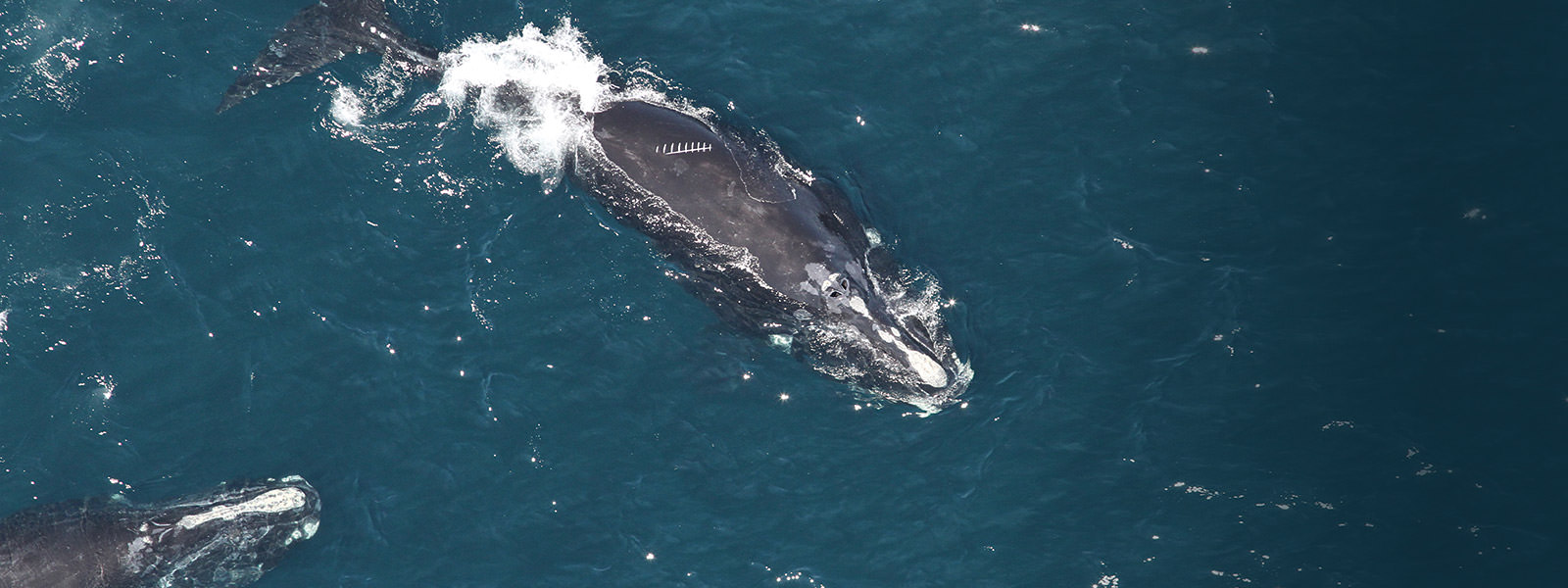- Home
- Explore the Blue
- Science & Sanctuaries
Finding Sanctuary for Right Whales

For years, North Atlantic right whales were hunted for their oil and baleen, which devastated the population. Despite current protection under the Endangered Species Act, this critically-endangered whale is in crisis, with only about 450 remaining. There is some good news, though: NOAA scientists, resource managers, and partners are working to galvanize efforts to save the North Atlantic right whale. Stellwagen Bank National Marine Sanctuary research coordinator Dr. David Wiley is one such scientist.
How do North Atlantic right whales use Stellwagen Bank National Marine Sanctuary?
Dr. Wiley: Stellwagen Bank is located off the coast of Massachusetts, and is an incredibly rich feeding ground for whales like right whales. We see them feeding on dense concentrations of zooplankton. In the sanctuary, they also engage in surface active groups, where numerous whales get together to roll around, rub against each other, and socialize.
What are you trying to learn about right whales' role in the sanctuary?
The main problem these whales face is injury or mortality caused by entanglement in fishing gear and collisions with large ships. We map how the whales use the sanctuary, so we can try to separate them from danger.
Noise from shipping is also making it harder and harder for right whales to communicate with each other, so we have been using passive acoustics to map the soundscape of the sanctuary. Dr. Leila Hatch, the sanctuary's marine ecologist, and her team have calculated that noise from shipping has diminished right whale communication space in the sanctuary by almost 70 percent.
We try to learn as much as we can about the human activities that interact with right whales. Since we cannot change right whale behavior, our only hope is to modify the human activities that harm them.
How are Stellwagen Bank National Marine Sanctuary and your partners addressing the North Atlantic right whale crisis?
We have a bunch of projects focused on right whales. We led the creation of the Whale Alert mobile app, which is a free app that allows mariners and the general public to see all right whale management requirements displayed on nautical charts. People can also use Whale Alert to report right whale and other whale sightings, and to notify the proper authorities if they see a right whale or any other marine life in distress.
We also led the development of the world's first near real-time acoustic detection system for right whales, which help warn mariners and other boaters when there is a right whale in the shipping lanes. The buoys also help us track how frequently right whales are in the sanctuary – we're finding they're here for the majority of days of most months of the year.
We've also found it crucial to collaborate with commercial industries to encourage right whale protection. We've worked with the Massachusetts Port Authority, the Coast Guard, and the International Fund for Animal Welfare (IFAW) to create the Right Whale Corporate Responsibility Project, which provides deserving companies with positive attention for their efforts to protect the whales. We've also worked with the Massachusetts Lobstermen's Association to reduce entanglement risk.
Why do you care about right whales?
In terms of large whales, North Atlantic right whales are the conservation challenge of our time. Saving them will require working collaboratively with diverse partners and stakeholders. At Stellwagen Bank National Marine Sanctuary, we have a history of working productively with stakeholders, and we hope to continue and improve upon those efforts.
Please note that it is illegal to intentionally approach within 500 yards of a North Atlantic right whale. If you find your vessel within this buffer zone, depart immediately at a safe, slow speed. As a whale watcher, you can support companies that commit to using best practices and protecting the ocean through programs like Whale SENSE. If you see an injured or entangled whale, please call the 24-hour NOAA hotline at 1-888-256-9840.


